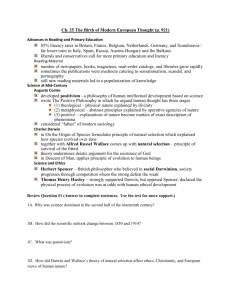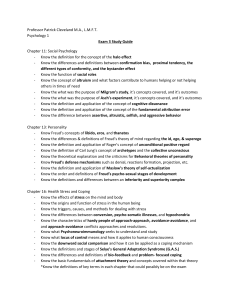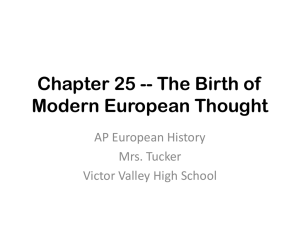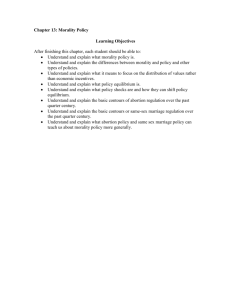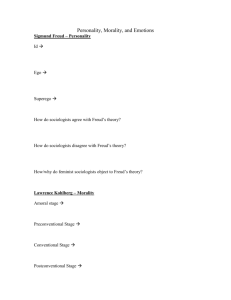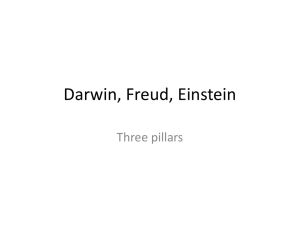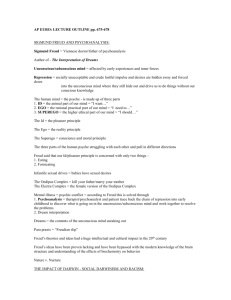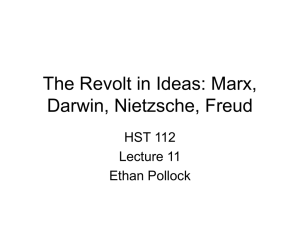The Crisis of the French Monarchy
advertisement
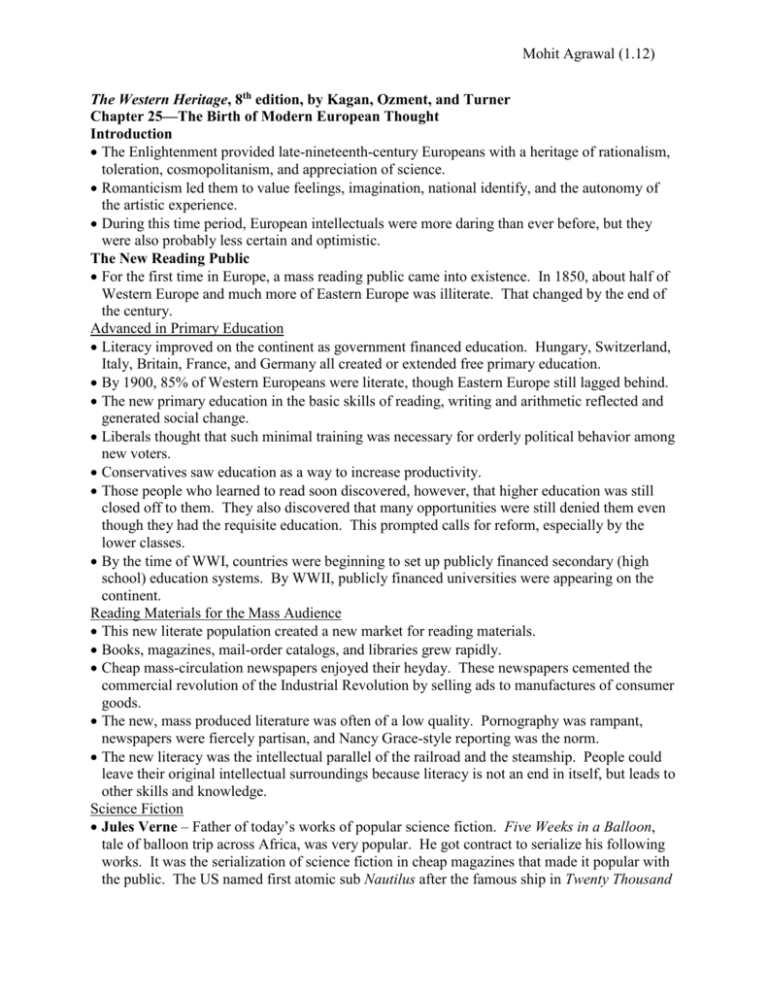
Mohit Agrawal (1.12) The Western Heritage, 8th edition, by Kagan, Ozment, and Turner Chapter 25—The Birth of Modern European Thought Introduction The Enlightenment provided late-nineteenth-century Europeans with a heritage of rationalism, toleration, cosmopolitanism, and appreciation of science. Romanticism led them to value feelings, imagination, national identify, and the autonomy of the artistic experience. During this time period, European intellectuals were more daring than ever before, but they were also probably less certain and optimistic. The New Reading Public For the first time in Europe, a mass reading public came into existence. In 1850, about half of Western Europe and much more of Eastern Europe was illiterate. That changed by the end of the century. Advanced in Primary Education Literacy improved on the continent as government financed education. Hungary, Switzerland, Italy, Britain, France, and Germany all created or extended free primary education. By 1900, 85% of Western Europeans were literate, though Eastern Europe still lagged behind. The new primary education in the basic skills of reading, writing and arithmetic reflected and generated social change. Liberals thought that such minimal training was necessary for orderly political behavior among new voters. Conservatives saw education as a way to increase productivity. Those people who learned to read soon discovered, however, that higher education was still closed off to them. They also discovered that many opportunities were still denied them even though they had the requisite education. This prompted calls for reform, especially by the lower classes. By the time of WWI, countries were beginning to set up publicly financed secondary (high school) education systems. By WWII, publicly financed universities were appearing on the continent. Reading Materials for the Mass Audience This new literate population created a new market for reading materials. Books, magazines, mail-order catalogs, and libraries grew rapidly. Cheap mass-circulation newspapers enjoyed their heyday. These newspapers cemented the commercial revolution of the Industrial Revolution by selling ads to manufactures of consumer goods. The new, mass produced literature was often of a low quality. Pornography was rampant, newspapers were fiercely partisan, and Nancy Grace-style reporting was the norm. The new literacy was the intellectual parallel of the railroad and the steamship. People could leave their original intellectual surroundings because literacy is not an end in itself, but leads to other skills and knowledge. Science Fiction Jules Verne – Father of today’s works of popular science fiction. Five Weeks in a Balloon, tale of balloon trip across Africa, was very popular. He got contract to serialize his following works. It was the serialization of science fiction in cheap magazines that made it popular with the public. The US named first atomic sub Nautilus after the famous ship in Twenty Thousand Mohit Agrawal (2.12) Leagues under the Sea. Verne made his stories contemporary so that readers would feel more involved. Most of his science depicted was real. H.G. Wells—The famous English author was one generation younger than Jules Verne. He published the popular The Time Machine, The Island of Dr. Moreau, and The War of the Worlds. Wells’ science was mostly fictional but his revolutionary new works shook up the literary world. Science at Mid-century Science at mid-century had changed little from the time of Newton. It was still based on the idea of a mechanical, orderly, and rational world. However, the rise of the French and German research institutions/universities meant that groundbreaking research was just around the corner. Comte, Positivism, and the Prestige of Science Auguste Comte – A French philosopher who developed positivism, a philosophy of human intellectual development that culminated in science. He wrote The Positive Philosophy, in which he argued that human thought develops in 3 stages. Theological: physical nature explained as action of divinities or spirits. Metaphysical: abstract principles regarded as operative agencies of nature. Positive stage: nature explanations are exact description of phenomena. He said physical science was in the positive stage. He established science as the model of all human knowledge. Comte also believed that laws of social behavior could be discovered like physical, scientific laws. He is thus regarded as the father of sociology. People in Europe generally believed Comte’s argument. Science was on the ascent in the Continent, and the general public believed that science would eventually be able to answer all questions. Darwin’s Theory of Natural Selection Charles Darwin – On the Origin of Species explained life through a mechanical interpretation. The concept of evolution had existed long before Darwin; he only formulated the principle of natural selection by which evolution could occur. Darwin drew on Malthus and said more organisms come into existence than can survive in environment. Only the best survived long enough to reproduce, however. This was natural selection. The idea that physical/organic nature might be constantly changing allowed people to believe that society, values, customs, and beliefs should change too. He cast doubt on Creation. In The Descent of Man, Darwin argued that man and society had developed as it had naturalistically, as our ancestors strove to survive their situation. The Church was hardly pleased. Gregor Mendel – Austrian monk who studied separate generations of pea plants and bred these plants. He figured out how there was variation between different plants, but he didn’t discover genes, just the fact that there seemed to be a pattern between parent physical characteristics and that of offspring. Mendel’s work led to modern genetics. Modern genetics has now essentially proven the theory of natural selection. Science and Ethics Philosophers applied the concept of the struggle for survival to human social relationships. The phrase “survival of the fittest” didn’t come from Darwin but instead from classical economists. Its cross applicability convinced people that competition was present not just in economics or natural selection but in all parts of life. Mohit Agrawal (3.12) Herbert Spencer – Advocated improving women’s lot, but didn’t think women could achieve equality with men. He also believed human society progresses through competition; if weak receive too much protection, rest of humankind is a loser. Struggle against fellow humans became kind of ethical imperative. This is usually termed social Darwinism. He is most famous advocate of evolutionary ethics. Social Darwinism is a perversion of Darwin’s views that was used to restrict welfare and was an excuse for slavery. It basically says that might is right. T.H. Huxley, however, attacked social Darwinism. He supported Darwin’s work, but he did not support its application to humanity. Huxley declared that the physical process of evolution was at odds with human ethical development. He said that people should avoid the competition of evolution and that our competitive urges was just a harkening back to the state of nature. Christianity and the Church under Siege Though science was chipping away at Christianity, the Protestant and Catholic churches remained popular. Intellectual Skepticism The intellectual attack on Christianity challenged its historical credibility, its scientific accuracy, and its morality. History David Friedrich Strauss – Published The Life of Jesus in 1835, where he questioned whether Bible provides any genuine historical evidence about Jesus. He said story of Jesus is a myth made by first-century Palestinians and is the aspirations of the people of that time/place rather than real events. Other people said that the Bible had been edited/updated/made-up to improve upon Judaic society. People started to view the Bible as fallible. They said that, like Homeric epics, it was written by real people. The questioning of the historic validity of the Bible hurt Christianity the most in Europe. Science 18th century writers had said that the pursuit of science would help uncover and prove basic truths from the Bible. The biggest proponent of this was William Paley in his Natural Theology. As science developed, however, this idea was found to be false. For example, Charles Lyell’s geology suggested the earth is much older than biblical records contend. He used natural causes to explain floods, mountains, and valleys, and thus removed God from physical development of earth. Morality The morality of the Old Testament God, his cruelty and unpredictability, did not fit well with the tolerant, rational values of liberals. That the New Testament God would allow Jesus to die also haunted Europeans. Nietzsche also criticized Christianity for promoting weakness. It demanded a useless and debilitating sacrifice of flesh and spirit, rather than promoting the Greek ideas of heroic living and daring. Overall, many upper class and educated Europeans became secular. States stopped actively supporting the Church, and the secularization of society led more and more people to abandon the Church. Secularization moved especially quickly in the cities. Conflict between the Church and State Mohit Agrawal (4.12) States clashed with both Protestant and Catholic churches. States were especially suspicious of the supranational character of the Catholic Church. The primary area of contention was education, however. Church schools had long been the education system of Europe. The church feared that as future generations were educated outside the church system, they would emerge without a religious background and would be more susceptible to secularism. Great Britain The Education Act of 1870 provided for state schools, instead of just giving money to religious schools. It also pushed for new, non-religious schools to be built in underserved areas. It also pushed for reforms in techniques and curriculums. Religious schools opposed such reform because it meant higher costs of operation for them. The Education Act of 1902 gave money to religious schools again but forced them to meet state standards. France France had a dual system of both religious and public schools. Under the Falloux Law of 1850, the local priest provided the religious education in the public schools. The Third Republic moved to sever these ties. A series of laws repealed the Falloux Law and replaced religious education with civic education. More public schools were built and those of religious orders could not teach in them. In 1905, the Napoleonic Concordat was terminated. The church and state were separated. Germany and the Kulturkampf Germany had the most extreme conflict. In 1870, Bismarck removed the clergy from overseeing local education in Prussia and set education under state direction. This secularization of education represented the beginning of a concerted attack on the Catholic Church in Germany. The May Laws of 1873 required the clergy to be educated in state schools and pass state exams. Moreover, control over the Church in Prussia was legislated away from the pope and given to the government. The government could also veto church appointments. Bismarck had to expel all current clergy from Prussia because they did not accept the May Laws. Eventually, as Catholics in Prussia got angry, Bismarck had to give in on many Church demands. In the end, the slight gain in state power that Bismarck got from his Kulturkampf was not enough for the price he paid in the support of his Catholic citizens. Areas of Religious Revival In Great Britain, churches generally expanded. They fundraised money and built new churches and schools. There was a Catholic revival in Ireland in the 1870s. The defeat of France in the Franco-Prussian War was blamed by many on the country’s sins. This also sparked a Catholic revival. By paying more attention to the poor, many churches did some good and increased their number of members. The Roman Catholic Church and the Modern World The most striking feature of religion in Europe was the resilience of the papacy. Mohit Agrawal (5.12) Pius IX – In 1860s, he launched counteroffensive against liberalism. He issued Syllabus of Errors, which set Catholic Church squarely against contemporary science, philosophy, and politics. He summoned First Vatican Council in 1869, which promulgated dogma of papal infallibility when speaking officially on matters of faith and morals. Pius centralized authority within church, which no one earlier had done to such degree. He believed church could only sustain itself w/ large electorates by centering authority of church in papacy. It was in 1870 that the Church lost its Papal States and was limited to just the Vatican. Pius was succeeded by Leo XIII in 1878. Leo sought to make accommodations to the modern age and to address its great social questions. He looked to the philosophy of Thomas Aquinas for inspiration. Leo’s most important work was Rerum Novarum. In it, he laid down a modern, political philosophy of Catholicism. He defended private property and religious schools and attacked socialism and Marxism. He said that workers ought to be protected inside the capitalist system, however, and should be paid proper wages and allowed to form unions. This work is the central focus of modern Christian/Catholic parties in European politics today. Leo’s successor, Pius X, moved the church more towards his namesake. He forced all his clergy to take an anti-Modernist oath. Toward a Twentieth-Century Frame of Mind Science: The Revolution in Physics By the late 1870s, discontent existed over the excessive realism of mid-century science. Ernst Mach – In 1883, published The Science of Mechanics, where he urged scientists to consider their concepts as descriptive not of physical world, but of sensations experienced by scientific observer. Scientists describe sensations, not physical world that underlie these. Henri Poincaré – Urged theories of scientists to be regarded as hypothetical constructs of the human mind and not as true descriptions of nature. Hans Vaihinger – said concepts of science should be considered “as if” descriptions of physical world, instead of absolute truths. X-Rays and Radiation Wilhelm Roentgen – He published his paper on his discovery of X-rays, a form of energy that penetrated various opaque materials, in 1895. His work led to a flurry of research on X-rays and radiation. Henri Becquerel – In 1896, he discovered that uranium emitted similar form of energy as X rays (form of energy that penetrated various opaque materials) that Roentgen discovered. Ernest Rutherford – In 1898 he reported the existence of alpha and beta rays in uranium radiation and indicated some of their properties. In 1902, he explained the cause of radiation thru disintegration of the atoms of radioactive materials. He speculated on huge store of energy in atom. Marie and Pierre Curie – Marie is credited w/ discovery of radium, for which she was awarded Nobel Prize in Chem in 1911. They are two of the most important figures in the advance of physics and chemistry at the turn of the century. The Atom J.J. Thompson – Formulated theory of electron at Cambridge. (using cathode ray tube, he figured out the electric charge/mass ratio of an electron) Rutherford also made contributions to the structure of the atom. In 1910, his investigations into the scattering of alpha rays and the nature of the inner structure of the atom which caused Mohit Agrawal (6.12) such scattering led to the postulation of his concept of the "nucleus", his greatest contribution to physics. According to him practically the whole mass of the atom and at the same time all positive charge of the atom is concentrated in a minute space at the center. Theories of Quantum Energy, Relativity, and Uncertainty Max Planck – In 1900, he pioneered articulation of the quantum theory of energy; energy is a series of discrete quantities, or packets, rather than continuous stream. (Preceded relativity of Einstein) Albert Einstein – In 1905, he published his papers on relativity that stated time and space exist as a combined continuum. Also, the measurement of time and space depends on the observer as well as on the entities being measured. This set the fundamental theory of physics in a new direction and challenged previous Western thought of science, literature, politics, and philosophy. Werner Heisenberg – In 1927, he made uncertainty principle, the idea that the behavior of subatomic particles is a matter of statistical probability rather than exactly determinable cause and effect. You cannot know the exact location and speed at the same time. Science and Society The complexity of the new science meant that it lost some of its luster with the public. However, it gained many new applications in industry. Industry started to become a central source of research. Governments also began supporting research. Scientists related science to economic progress, military security, and the health of their nations. Literature: Realism and Naturalism The realist movement portrayed the hypocrisy, brutality, and the dullness that underlay bourgeois life. Realist and naturalist writers brought scientific objectivity and observation to their work. Realism rejected the romantic idealization of nature. It portrayed the dark side of life instead. Early realist writers included Charles Dickens, Honore de Balzac, and George Eliot. They portrayed the cruelty of industrial life and of a society based on money. They also constructed detailed characters. Their works, however, included imagination and artistry. They described a better morality possible though Christian or humane values. The major figures of later realism examined the dark side of life without being certain that a better life was possible. They showed humans as overly passionate and materialistically deterministic. They saw society as perpetuating evil itself. Gustave Flaubert – Wrote Madame Bovary, a story of colorless life and woman’s search for love in and out of marriage. Regarded as the first genuinely realistic novel. It portrayed life without heroism, purpose, or civility. Emile Zola – He turned realism into a movement. He argued he could write an experimental novel that reported characters like a science experiment. He believed absolute physical and psychological determinism ruled human events like in the physical world. Between 1871 and 1893, he explored topics of alcoholism, prostitution, and labor strife; he didn’t try to get away from reality. Zola also took a leading role in the defense of Dreyfus. Henrik Ibsen – Norwegian playwright who carried the realistic portrayal of domestic life onto the stage. He sought to strip away illusory mask of middle-class morality. A Doll’s House: Nora has husband who can’t tolerate independence of character or thought on her part. She finally leaves him. In Ghosts, a respectable woman must deal w/ son suffering from syphilis Mohit Agrawal (7.12) inherited from husband. In The Master Builder, aging architect kills himself while trying to impress a young woman. Ibsen attacked sentimentality, ideal of female “angel of the house,” and cloak of respectability. George Bernard Shaw – Supported Ibsen, and made his own realistic onslaught against romanticism and false respectability. In Mrs. Warren’s Profession, he dealt w/ prostitution; in Arms and the Man and Man and Superman he heaped scorn on romantic ideals of love/war; in Androcles and the Lion, he denounced Christianity. Realists hoped to destroy the illusions of society and compel the public to face reality. They wanted to remove the veneer of hypocrisy that had forbidden the discussion of pressing contemporary issues. Realists, however, rarely offered solutions and left people depressed and without hope. Modernism From 1870 onwards, modernism touched all the arts. Like realism, modernism was critical of middle class society and morality. Modernism, however, was not deeply concerned with social issues. What drove the modernists was s concert for the aesthetic or beautiful. They wanted to make all art more fluid like music. Modernists tried to create new forms of art. They combined previous sources into new amalgams, like Igor Stravinsky did in his ballet The Rite of Spring. Cubism Pablo Picasso and other artists associated with cubism constructed paintings that involved viewing objects from a variety of angles at the same time. Cubism emerged in the heady turn-of-the century cultural climate that fostered changes in science, literature, etc. For hundreds of years, Western painting had sought to portray reality. Even Impressionism and post-Impressionism was essentially realistic in nature. This age also marked a new sensitivity in regard to non-Western peoples and their art. Beginning in 1907, Picasso rejected the idea of a painting as constituting a window looking onto the real world. Instead, he saw painting as an autonomous realm of art itself with no purpose beyond itself. Echoing the art of Egypt, Picasso represented only two dimensions in his painting. They saw “reality” as the construction of multiple perceptions, and thus including many different perspectives in their paintings. In cubism, “The true picture will constitute an individual object, which will possess an existence of its own apart from the subject that has inspired it.” Bloomsbury Group The chief proponents of modernism in England were the members of the Bloomsbury Group. These authors challenged the values of their Victorian forebears. In both personal practice and theory, the Bloomsbury Group rejected what they regarded as the repressive sexual morality of their parents’ generation. Virginia Woolf – She took a unique stance with feminist literature with her publication of A Room of One’s Own. Here, she told of the difficulties that women of brilliance and social standing encountered in being taken seriously. She said woman must have a room of her own (not dominated by men), and an independent income. She also wondered whether women should imitate men or bring their own experiences (intellectual and psychological) into their writing. She said they should do the latter, and thus challenged literary conventions of the Mohit Agrawal (8.12) traditional novel. Her novels, including Mrs. Dalloway and To the Lighthouse portrayed individuals seeking to make their way in a world with most of the nineteenth-century social and moral certainties removed. Other Modernist Literature Marcel Proust adopted a stream of consciousness format that allowed him to explore his memories. In his seven-part novel In Search of Time Past, he would concentrate on a single experience or object and then allow his mind to wander through all the thoughts it provoked. Thomas Mann, in his Buddenbrooks and The Magic Mountain, explored both the social experience of middle-class Germans and how they dealt with the intellectual heritage of the nineteenth century. James Joyce, of Irish heritage, changed not only the novel but also the structure of the paragraph in the epic modernist work Ulysses. Modernism in literature arose before WWI but flourished on the turmoil and social dislocation that the war caused. Friedrich Nietzsche and the Revolt against Reason After 1850, philosophers began to question the adequacy of rational thinking to address the human situation. Friedrich Nietzsche –He attacked Christianity, democracy, nationalism, rationality, science, and progress. He wanted to probe the source of human thought and values. The Birth of Tragedy: said the nonrational aspects of human nature are as important as the rational. He insisted that instinct and ecstasy had positive functions. He denounced Socrates who believed solely in rationality. Nietzsche thought that the nonrational aspects are what really characterized human life; the nonrational was where heroism came from. Wrote Thus Spake Zarathustra that criticized democracy and Christianity. He thought that they only led to the mediocrity of society. He announced the death of God and coming of the Overman in Overman. The Overman embodied heroism like in Greek life in the Homeric age. He also criticized anti-Semitism in the work. He wrote Beyond Good and Evil and The Genealogy of Morals to try to find social and psychological sources of our perception of what is good and evil. These books questioned morality itself. He said that since morality was a human construction, we could throw away Christianity and our other morals and re-emphasize pride, assertiveness, and strength. He said that the world was always in flux and never permanent. His appeal to feelings and emotions and his questioning of rationalism draws on the Romantic tradition. The Birth of Psychoanalysis A determination to probe beneath public appearance united the major figures of late-nineteenth century science, art, and philosophy. Sigmund Freud – He was an Austrian Jew who lived in Vienna. He had his medical practice there until driven out by the Nazis. He applied the new analytic methods to psychology. Freud published Studies in Hysteria in 1895 that examined hypnosis to treat hysteria. Later, Freud found that patients always linked their neurotic problems with earlier experiences, many times to childhood. Sexual matters were also significant in patient’s problems. Freud thought for time that this accounted for their illnesses. Mohit Agrawal (9.12) In 1897, he developed the theory of infantile sexuality. He said that sexual drives and energy already existed in infants and thus questioned the idea of childhood innocence. He said that humans are at the most basic level sexual creatures. He also believed that irrational dream content has scientific explanation. He thought that dreams allow unconscious wishes, desires, and drives that were excluded in conscious life to enjoy free play in the mind. In fact, Freud argued, unconscious drives and desires contribute to conscious behavior. He published his most important book on infantile sexuality and dreams, The Interpretation of Dreams, in 1900. Later, Freud developed a new model of the mind as an area of struggle of 3 entities: id – amoral, irrational, driving instincts for pleasure; superego – external moral imperatives/expectations of society placed on someone; and ego – balances id and superego. Personality is determined by physical/mental forces in a finite world. He believes suppression of id causes disorders, but that some degree of suppression is necessary for civilization to function. Freud was hostile to religion and spoke of it as an illusion. Freud was generally pessimistic about the future of civilization in the West. Divisions in the Psychoanalytic Movement By 1910, Freud had several devoted students. Jung was the most promising of these, but before WWI Freud and Jung split. Carl Jung – Jung thought human subconscious contains inherited memories from previous generations. These and personal experience constitute the soul. In Modern Man in Search of a Soul and other works, Jung tended toward mysticism and saw positive values in religion. He thought 1900s people were alienated from collective memories. Jung questioned the primacy of sexual drives in forming personality and contributing mental disorder. He put less faith in reason. Psychoanalysis involved sociology, anthropology, religion, and literature. Whether it is eventually proven true or not, psychoanalysis deeply influenced the intellectual life of the twentieth century. Weber attacks Islam and Marx Max Weber – He was a sociologist that dismissed Islam as a religion and culture incapable of developing science and closed to new ideas. He regarded emergence of rationalism throughout society as major development of human history. He, unlike many other modernists, supported rationalism. His seminal work, The Protestant Ethic and the Spirit of Capitalism attacked many of Marx’s views. Weber saw bureaucratization as basic feature of modern social life, not capitalism as Marx thought. Bureaucratization involved division of labor in large organizations. He also said noneconomic factors might account for developments in human history. In his work, he traced the emergence of capitalism to the Puritan work ethic. Retreat from Rationalism in Politics The ideas that people vote for their rational political self-interest and that education improved the human condition were attacked. Political scientists and sociologists painted politics as frequently irrational. People questioned whether rationality and education could affect human society at all. Many psychologists, sociologists, and political scientists were studying the idea of collective behavior. In general, they said that people in crowds tend to behave irrationally. Instinct, habit, and affection, instead of reason, drive human behavior. Mohit Agrawal (10.12) Collective behavior also applies to situations without crowds. People make decisions based on their values, but their values are set by society. Thus, they make decisions to conform to society (like a mental “mob” mentality). This is not true, independent, rational thought. Racism and Nationalism Racism had long existed in Europe (documented since before the Renaissance). Since the 1700s, scientists had classified people as different races based on skin color and language. Sensing the similarities between the Indo-European languages, Europeans hypothesized that they were the direct descendents of a master “Aryan” race. Other peoples were outcasts of this great Aryan society. What transformed racial thinking at the end of the century was its association with the biological sciences. Europeans claimed that racial science supported a hierarchy of superior and inferior races. Arthur de Gobineau – He was a French reactionary diplomat who said that you could understand human history by understanding the human races. In his Essay on the Inequality of the Human Races, he says that the troubles of the West are due to the degeneration of the original white Aryan race by marrying into other races over centuries. Houston Stewart Chamberlain – An Englishman who settled in Germany, he wrote the influential racist tome, Foundations of the Nineteenth Century. Chamberlain believed that most people in the world are racially mixed and that this mixture weakens the purity of human characteristics. He believed that people who were assured of their racial purity could act with the most extreme self-confidence and arrogance. He believed that human race could be improved and a superior race developed through genetics and eugenics. He was anti-Semitic— Jews were enemy of Euro racial regeneration. Racism was just a new manifestation of nationalism. Nationalism had been a good thing in Europe, used to redraw the borders of countries. From the 1870s onwards, however, national became a movement with mass support, spawning many organizations and political parties. Nationalists often redefined nationalism in terms of race and blood. The new nationalism opposed internationalism, liberalism, and socialism. For many people, it became almost a second religion. Nationalism of this aggressive, racist variety became the most powerful ideology of the early 1900s and would reemerge after the collapse of communism in the 1990s. Zionism and Anti-Semitism Anti-Semitism had dated back through the Middle Ages, but now it was mainly due to economics and not really religion. Whenever people had money problems, it was popular to blame the Jews. Mayor Karl Leuger of Vienna used anti-Semitism to attract support for his Christian Socialist Party. The ultraconservative Lutheran Adolf Stoecker spread anti-Semitism in Germany. It spread in France through the Dreyfus affair. Anti-Semitism now took on parts of this “biological” racism debate. Jews were impure not because of their religion, but because of their blood. This certainly makes anti-Semitism more powerful than ever before. The Zionist movement rose in response to this anti-Semitism. It wanted to create a separate state for the Jews. Theodor Herzl – Austro-Hungarian who founded the Zionist movement to found a separate Jewish state. Dreyfus hearing, election of Lueger as mayor of Vienna, and personal experience led him to think that liberal politics/institutions couldn’t protect Jews. He published The Mohit Agrawal (11.12) Jewish State, calling for separate state for Jews to obtain equal rights. He directed appeal towards poor Jews to add in desire of ideals of liberalism and socialism to rejection of antiSemitism. Women and Modern Thought Antifeminism in Late-Century Thought The emphasis on biology, evolution, and reproduction led many people to stereotype women into a mothering role. Many late-century thinkers also often displayed real fear and hostility towards women, portraying them as creature susceptible to destructive feelings and instincts. Darwin himself believed that women were weaker and less able than men. Huxley wrote articles and pamphlets explaining how women were servile to men. Women were excluded from many prominent scientific and other organizations because such amateurs were unfit to participate among the masters. This explains to a large party why women had so much trouble getting into higher education until well into the 1900s. Freud saw the natural destiny of women as motherhood and the rearing of sons. Comte, basing his thoughts on Rousseau, portrayed women as biologically and intellectually inferior to men. HS Spencer thought that women could never achieve equality with men. New Directions in Feminism The close of the century witnessed a revival of feminist thought in Europe that would grow in the twentieth century. Sex and Marriage Roles Middle-class women began to challenge the double standard of sexual morality and the traditional male-dominated family. Many times this involved changing laws and attitudes towards prostitution. Between 1864 and 1886, English prostitutes were subject to the Contagious Diseases Acts. Any women suspected of being a prostitute could be examined for STDs. If she was infected, she would be locked up for months in a women’s hospital, where she would supposedly “undergo” treatment. Men who solicited prostitutes were, of course, not affected by the law. The act treated women as less than rational human beings. It literally put women’s bodies under the control of male customers, male physicians, and male law-enforcement personnel. Many English women saw this as a punishment of young, poor women, who could find no other job in the male-dominated society. They compared the plight of these women to those who were denied entrance to higher education or professional school. The act was finally repealed after decades of feminist opposition. The tenets of marriage were also challenged by feminists. In their view, marriage should be a free union of equals with men and women sharing responsibility for their children. Virtually all late-century feminists supported changes in sexual morality. They wanted wider sexual freedom, which they claimed would improve women’s lives. Women at this time also began pushing for contraception. They believed that a woman should be able to control when she got pregnant. Role in Society Overall, feminists also wanted to give women more of a say, not only in her own life, but also in society as well. Many pushed for the vote. Of course, suffrage was probably the major feminist cause of the period. Mohit Agrawal (12.12) Increasingly, feminists would concentrate on freeing and developing women’s personalities through better education and gov support. Feminists also became active in socialists circles. By the close of the century, socialist writings began to include calls for improvement in the economic situation of women. Remember, many socialists had traditionally believed in free sex. Thus, the two groups were natural allies. Feminism became associated with liberal politics. Thus, extremely conservative political movements often emphasized traditional roles for women.
